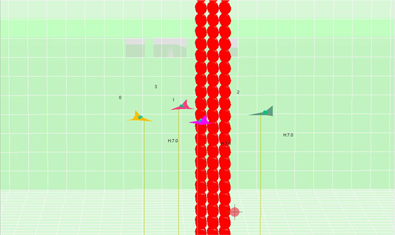Automatic Air Navigation and Collision Avoidance Model Developed
Researchers from the Department of Artificial Intelligence at the Universidad Politécnica de Madrid's Facultad de Informática have developed an automatic air navigation and collision avoidance model using an automatic learning system.
Based primarily on how living beings learn to perceive motion, the model builds software using a simulator-based learning process. Built into the aircraft avionics, the resulting software aligns aircraft flight paths with other nearby aircraft in a dense airspace, like an airport, for example, avoiding collisions. If it is heading towards a building, the aircraft automatically avoids the obstacle. Likewise, if several aircraft are to land on the same runway, the system prioritizes landing manoeuvres without human intervention.
The model has experienced all the major combinations of in-flight incidents in the simulator, learning how to solve from the simplest to the most complex contingencies satisfactorily thanks to its in-built bio-inspired algorithm.
Multiple aircraft, obstacles, danger zones or prohibited airspace
The model, which can be tailored to each aircraft according its flight characteristics, is the result of a National R&D Plan research project led by the UPM's Facultad de Informática and partnered by the Escuela Superior de Ingenieros Aeronáuticos (UPM), EADS and AENA. This research was developed by professors Santiago Álvarez de Toledo and José María Barreiro Sorrivas.
The software built by the model in simulation is capable of automatically navigating an aircraft and steering it to a target or consecutive targets. During navigation, the aircraft is capable of automatically avoiding collision with basically any physical obstacle in its path: other aircraft, land, geographical features and buildings. Additionally, it can avoid and skirt areas with adverse weather conditions, military operations areas, national airspace, etc.
The model has proved capable of avoiding all possible collisions with other aircraft, even if more than two aircraft are heading for the same spatial coordinates. Unlike current collision avoidance manoeuvres, the manoeuvres are not merely vertical (ascend/descend). Additionally, it is the pilot that activates collision avoidance manoeuvres today.
The model implements totally automatic 3D manoeuvres, where aircraft perform all sorts of turns with ascents and descents. The model controls all the manoeuvres from start to finish, without any pilot or air traffic control involvement or remote steering.
 To date the model has been used in a simulator with notable success, but its designers aim to implement it physically in real air navigation systems as an additional safety measure against human error.
To date the model has been used in a simulator with notable success, but its designers aim to implement it physically in real air navigation systems as an additional safety measure against human error.
The toughest problem in the implementation of this model was to automatically apply all pilot and air traffic controller experience to avoid collisions not only with other aircraft, mountains, land or buildings, but also in very dense air traffic environments, as in the vicinity of civil aviation airports, where an aircraft may be surrounded by other planes on all sides and perhaps also be only a short distance from the ground. This is a complexity that tends to increase at the same rate as air traffic and which this model is designed to tackle automatically.
.
SOURCE: FIUPM

